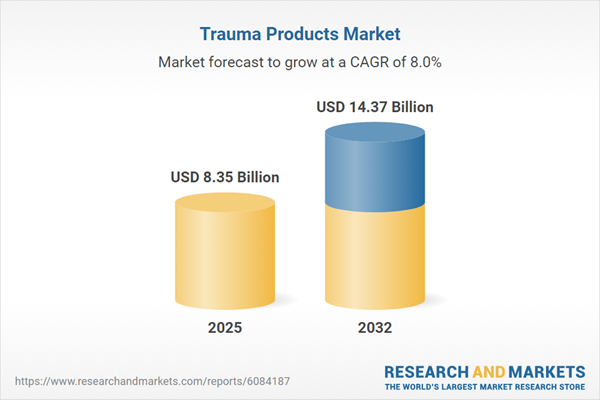Speak directly to the analyst to clarify any post sales queries you may have.
The trauma products market is evolving rapidly as demographic trends and technological innovation intersect with the growing demand for advanced clinical solutions. Senior leaders require a comprehensive view of the industry’s opportunities, risks, and strategic developments to inform high-impact decisions and secure a competitive edge.
Market Snapshot: Trauma Products Market Growth and Forecast
The trauma products market grew from USD 7.74 billion in 2024 to USD 8.35 billion in 2025. It is projected to maintain strong momentum with a CAGR of 8.03%, reaching USD 14.37 billion by 2032. This growth is driven by increasing orthopedic and trauma cases worldwide, propelled by an aging demographic, increased high-impact activities, and the widespread adoption of minimally invasive techniques alongside advanced biomaterials. The competitive landscape is characterized by continual innovation and expanded integration of digital technologies, positioning the market for long-term expansion and dynamic evolution.
Scope & Segmentation Coverage
This report provides in-depth segmentation and regional analysis to guide stakeholders through the complexity of the trauma products market:
- Product Types: External fixation devices (including hybrid, monolateral, and ring fixators), internal fixation devices (bone plates, bone screws, intramedullary nails), hemostatic agents, traction equipment, wound closure solutions (skin staplers, surgical sutures, tissue adhesives)
- End Users: Ambulatory surgical centers, hospitals and clinics, specialty orthopedic centers, trauma centers
- Distribution Channels: Direct sales, distributor partnerships, online sales platforms, retail pharmacies
- Material Types: Bioabsorbable polymers (PLGA, polyglycolic acid, polylactic acid), ceramic composites (hydroxyapatite, tricalcium phosphate), stainless steel, titanium alloys (commercially pure titanium, Ti-6Al-4V)
- Regions Covered: Americas (North America, Latin America), Europe, Middle East & Africa (Europe, Middle East, Africa), Asia-Pacific (including China, India, Japan, Australia, South Korea, Indonesia, Thailand, Malaysia, Singapore, Taiwan)
- Companies Profiled: Stryker Corporation, Johnson & Johnson, Zimmer Biomet Holdings, Smith & Nephew plc, Medtronic plc, B. Braun Melsungen AG, CONMED Corporation, Globus Medical, Integra LifeSciences, Wright Medical Group N.V.
Key Takeaways for Senior Decision-Makers
- Continued integration of digital platforms, advanced biomaterials, and patient-specific device design is reshaping product portfolios and clinical practices.
- Regulatory trends are accelerating innovation by streamlining approval pathways and emphasizing real-world evidence and post-market surveillance.
- Adoption of hybrid fixation systems and next-generation hemostatic agents is driving a shift toward more personalized and efficient care models.
- Distribution strategies now encompass direct and online sales as well as traditional channels, responding to end-user demand for speed and accessibility.
- Regional growth strategies reflect varying healthcare infrastructure, reimbursement systems, and clinical needs, supporting a diverse mix of scalable and premium solutions.
- M&A activity, alliances with biotech and digital health firms, and localized manufacturing are enabling market leaders to diversify their capabilities and address supply chain challenges.
Tariff Impact: Navigating New U.S. Trade Policies
Recent United States tariffs implemented in 2025 are influencing production costs and supply chain strategies for trauma devices. Manufacturers are exploring supplier diversification, local assembly, and value engineering to maintain price competitiveness and assure supply continuity. Distributors and providers must address rising procurement costs, potentially seeking efficiencies or new reimbursement approaches. Domestic and international firms alike are recalibrating commercial models in response to shifting trade dynamics.
Methodology & Data Sources
Research combines extensive primary interviews with orthopedic surgeons, trauma center leadership, procurement experts, and industry executives, alongside secondary data from peer-reviewed literature and regulatory filings. Quantitative and qualitative methods, including triangulation and simulation analysis, underpin findings and ensure robust, actionable insights.
Why This Report Matters
- Equips senior leaders with a granular analysis of market structure, emerging competitive dynamics, and high-impact regulatory changes.
- Enables informed decision-making through actionable segmentation, region-specific intelligence, and evidence-based commercial recommendations.
- Supports strategy development by highlighting both innovation drivers and practical challenges across the trauma product value chain.
Conclusion
The trauma products market is undergoing significant transformation, underscored by clinical, technological, and regulatory advancements. Companies that align strategies with these evolving dynamics will be best positioned to capture growth, drive innovation, and enhance outcomes.
Table of Contents
3. Executive Summary
4. Market Overview
7. Cumulative Impact of Artificial Intelligence 2025
Companies Mentioned
The companies profiled in this Trauma Products market report include:- Stryker Corporation
- Johnson & Johnson
- Zimmer Biomet Holdings, Inc.
- Smith & Nephew plc
- Medtronic plc
- B. Braun Melsungen AG
- CONMED Corporation
- Globus Medical, Inc.
- Integra LifeSciences Holdings Corporation
- Wright Medical Group N.V.
Table Information
| Report Attribute | Details |
|---|---|
| No. of Pages | 182 |
| Published | October 2025 |
| Forecast Period | 2025 - 2032 |
| Estimated Market Value ( USD | $ 8.35 Billion |
| Forecasted Market Value ( USD | $ 14.37 Billion |
| Compound Annual Growth Rate | 8.0% |
| Regions Covered | Global |
| No. of Companies Mentioned | 11 |









